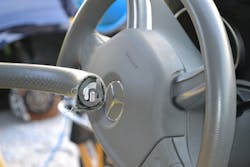University of Extrication: Skills Update: Steering Wheel Ops
Subject: Skills Update: Steering Wheel Ops
Topic: Steering Wheel Evolutions
Objective: Adapt and update task of partial or full removal of the steering wheel of a vehicle
Task: In a training environment with a rescue dummy positioned in the driver’s seat of an acquired vehicle, the rescue team shall practice various techniques for partial as well as full steering wheel removal.
Injuries received by drivers in frontal collisions many times can be the result of impact with the steering wheel and column assembly as the front of the vehicle collapses rearward. At an entrapment incident, responders may find that the driver is physically pinned at their legs or chest by the steering column or the steering wheel ring.
In 1967, the National Highway Traffic Safety Administration (NHTSA) created two safety standards (FMVSS 203 and 204) designed to reduce injury potential from steering columns. These columns are now energy-absorbing, collapsible and designed to minimize being propelled rearward during a frontal crash.
The focus of this Skills Update is just the steering wheel assembly—the ring and spokes unit that we use to steer a vehicle. Although different in their specific design, passenger vehicle steering wheel rings are all designed to absorb impacts and deform during the dynamics of a crash. To do that, manufacturers construct the steering wheel ring of soft, deformable, lightweight metal. It may be hollow, U-shaped or tubular, but it is all soft metal. This core of the steering wheel ring is covered with a plastic material that gives the ring its shape, feel and grip for the driver.
At a vehicle rescue scene with a driver contacted and pinned by the steering wheel ring, several rescue techniques are available that allow the ring to be moved or removed. If the crash is significant, dash-rolling or dash-jacking evolutions are generally performed to move all that “stuff” away from the front-seat occupants. But for our scenario, the driver is only caught by just the steering wheel ring. That is all that is pinning the patient. For rescuers who realize that steering wheel rings have soft, deformable cores, the ring can be partially removed or fully taken away using several quick and efficient techniques.
A very effective technique to use is the “Cut & Bend” evolution. One rescuer holds the steering wheel steady, while a second cuts through the steering wheel ring at the “9 o’clock” position. This is the outboard portion of the steering wheel ring and is selected because it is generally most accessible. While holding the top portion of the ring steady, the rescuer then lifts the lower cut portion of the steering wheel ring upward and to the right as if making a “right-hand turn”. This bends the bottom portion of the steering wheel ring away from where it might be trapping the patient and provides additional clearance between the steering wheel and the patient.
In actuality, the steering wheel ring, as well as any of the spokes holding the ring to the center hub of the steering column, can be cut at any point; they’re all soft, deformable metal inside a plastic or vinyl wrap. Cutting the center spokes would allow total steering wheel removal.
Steering Wheel Removal Process
- Hold the steering wheel steady
- Cut through at the 9 o’clock position
- Hold the bottom half of the ring and make a “right-hand turn”
- A second cut will remove the bottom half of the ring
- Cut the spokes to remove the entire ring assembly

Ron Moore
RON MOORE, who is a Firehouse contributing editor, recently retired as a division chief with the McKinney, TX, Fire Department and now serves with Prosper, TX, Fire Rescue. He self-published the Vehicle Rescue 1-2-3 training manual and serves as the forum moderator for the extrication section of Firehouse.com . Moore can be contacted directly at [email protected].






